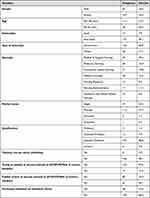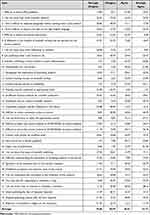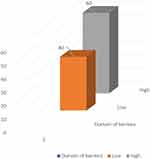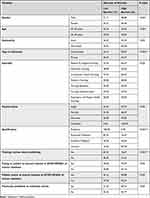Back to Journals » Journal of Multidisciplinary Healthcare » Volume 16
Barriers to Conducting and Publishing Scientific Research Among Nursing Faculty Members in Saudi Arabia
Authors Hakami MS
Received 31 July 2023
Accepted for publication 14 September 2023
Published 18 September 2023 Volume 2023:16 Pages 2733—2743
DOI https://doi.org/10.2147/JMDH.S429478
Checked for plagiarism Yes
Review by Single anonymous peer review
Peer reviewer comments 3
Editor who approved publication: Dr Scott Fraser
Manal SA Hakami
Nursing Department, Al-Baha University, Al-Baha, Saudi Arabia
Correspondence: Manal SA Hakami, Nursing Department, Al-Baha University, Al-Baha, 8088, Saudi Arabia, Tel +966566282822, Email [email protected]
Objective: Publication in highly indexed journals is a complicated process that requires research skills, including writing, conceptualizing, and communication skills, to appropriately verbalize the findings. The current study assessed the barriers faced by nursing faculty at Saudi universities in conducting scientific research and publishing in highly indexed journals.
Methods: This was a descriptive, cross-sectional study. Data were collected through convenience sampling by sending an online questionnaire to faculty members at Saudi universities. The questionnaire consisted of two parts: the first part for the demographic characteristics of staff and another part for the barriers associated with conducting scientific research and the publication process in highly indexed journals. The data was analyzed by SPSS using descriptive statistics as frequencies and percentages and inferential statistics using Chi Square test.
Results: The study included 152 participants, mainly female (70.4%) aged 30– 40 years (73.7%). Most were non-Saudi (90.1%), attended government universities (82.9%), and specialized in Medical & Surgical Nursing (29.6%). Only 3.9% received publishing training, whereas 55.9% had been published in indexed journals. Barriers included difficulties following guidelines, lack of research-writing knowledge, language challenges, and financial constraints. Gender, age, university, qualifications, and training courses influenced these barriers.
Conclusion: The identified barriers included lack of training, language-related challenges, and work pressures. This study emphasizes the importance of providing support, resources, and training opportunities to overcome these barriers and enhance research productivity in the nursing field.
Keywords: scientific research, publishing, nursing faculty, Saudi universities
Introduction
The academic process mainly focuses on teaching, searching, and serving communities in addition to research as one of the essential tasks for academics.1 Research on higher education is prioritized in developed countries for its development and innovation.2–4 Higher education institutions play a significant role in creating knowledge, discoveries, and development, and the only way to achieve this is to use a scientific approach.5–7 The number of publications and research productivity by faculty have declined substantially over the last two decades.8 Publications in nursing field focus on improving patient care, enhancing nursing education, participating in disease investigation, and approving scientific nursing interventions.9,10 The research was useless without publication in high-ranking journals.11
Recently, there has been an unpredictable increase in the number of global publishers and publications globally.12 The Scopus database contains more than twenty-five thousand peer-reviewed journals. In addition, the Web of Science Core Collection covers more than seven thousand journals.13 Nevertheless, the growing number of publishers and faculty members encountered obstacles when it came to publishing, including factors like academic standing and position, insufficient funding for research and publication, teaching responsibilities, and limited access to necessary equipment.14,15
Publication in high-indexed journals is a complicated process that requires research skills, including writing, conceptualizing, and communication, to appropriately verbalize the findings.16 Another barrier is that writing an article for publication requires a high level of academic writing skills in English, although not all researchers are native English speakers.17 Many other barriers to publishing a scientific article have been reported in several previous studies, such as poor technical skills, lack of time for writing,18 the teaching load of academics, lack of resources, lack of guidelines, lack of interest, lack of motivation or rewards, and lack of training on research and publishing.19,20
Nursing researchers have low research productivity due to similar barriers, which include lack of resources, scarcity of research material, technical difficulties, and lack of grants or research support.21,22 The higher educators are required to conduct scientific research and publishing as a part of their career development and its required for their promotion.23,24
Research on health science in Saudi Arabia has been conducted in collaboration with other universities and has not covered all health disciplines.25 Furthermore, investigating nursing research in the Arabian region, including Saudi Arabia, highlighted that 19% of the research was from Saudi Arabia out of 21 Arabian countries as a second country after Jordan, with 65% from King Saud University researchers; however, clinical research is still conducted by Western researchers and a need for further investigation.26 Moreover, the academic staff faced challenges to be promoted to associate professor and professor levels due to the lack of high-index publications. Therefore, the current study aimed to assess the barriers encountered by nursing faculty at Saudi universities when conducting scientific research and publishing.
Materials and Methods
Study Design
A descriptive cross-sectional study was conducted among nursing faculty at governmental and private universities in Saudi Arabia.
Study Population
The study was conducted on faculty members at nursing college in Saudi Arabia. The governmental and private nursing schools were included. The questionnaire link was distributed to the participants through social media, and they were asked to participate in the study after confirming that they are faculty members at nursing college. The participants who are not confirming the affiliation to nursing schools were excluded from the study.
Sampling and Sample Size
A convenience sampling technique was used, with a self-administered questionnaire distributed to the participants. The sample size was calculated using the following equation.
We assumed 10% of the study participants (p); thus, at a confidence level of 95% and an estimation error of 0.05 (d), while z value is constant at 1.96. The sample size was calculated as follows:
After adding 10% to compensate any attrition or no responses, the sample size was 152 participants.
Data Collection
Data were collected by sending an online questionnaire to the nursing faculty members at Saudi universities. The questionnaire was adopted from one previous study by Hendy et. al, 2022,16 and reviewed by two faculty members. The questionnaire consisted of two parts: the first part for demographic characteristics of staff and another part for the barriers associated with conducting scientific research and the publication process which includes thirty-four items for barriers to conducting research or publication. Scores were (strongly disagree = 0, disagree = 0, agree = 1, and strongly agree = 2) for each item. Higher scores indicate higher barriers, the score of 0 indicate that there is low or no barriers facing the faculty while 2 indicate that the barriers are high. The overall score was calculated as a high barrier of ≥ 60% and a low barrier of < 60%.
Pilot Study
The questionnaire was tested on ten faculty members at Al-Baha University to ensure its validity and reliability. The tested questionnaire was then revised by a statistician and reviewed by two faculty members to improve the accuracy and measurability of the tool. Cronbach’s alpha for the pre-tested questionnaire was acceptable (above 0.7). This indicates an internal consistency of the scale items.
Data Analysis
Data were entered, coded, and analyzed by IBM SPSS (the Statistical Package for the Social Science) version 26. The researcher used this software due to its well-established reputation and suitability for the research objectives. A descriptive analysis of frequencies and percentages was applied for nominal and ordinal variables, whereas the mean, median, and standard deviation or range were applied for numerical data. The association between demographic characteristics and domains of barriers was investigated using Chi Square test with a p-value less than 0.05, which was considered statistically significant.
Ethics Approval and Consent to Participate
Ethical approval was obtained from the Ethics Committee of Al-Baha University (approval number 44117035 on 28/02/2022). Participants were assured that their names and information were kept confidential and that they had the right to withdraw at any time from the study. The participants provided informed consent to participate in the study and confirmed that they are faculty members at Saudi Universities.
Results
Table 1 provides an overview of the socio-demographic characteristics of the 152 participants. Many participants were female (70.4%) and within the age range of 30–40 years (73.7%). Most of the participants were non-Saudi (90.1%) and had attended government universities (82.9%). In terms of nursing specialties, the highest representation was in Medical & Surgical Nursing (29.6%), followed by Maternity Nursing (16.4%) and Community Health Nursing (13.8%). Most participants were married (73.7%) and held assistant professors (86.8%). Only a small proportion had received training courses on publishing (3.9%) while higher proportion have published articles in journals indexed in the SCOPUS/Web of Science databases (55.9%). Overall, 31.6% of participants had previously published individual articles.
 |
Table 1 Participants Socio-Demographic Characteristics (N = 152) |
Table 2 illustrates the barriers affecting scientific research and publishing, as reported by 152 participants. The table presents the frequency of responses across four categories: “strongly disagree”, “disagree”, “agree”, and “strongly agree”. The participants identified that they have difficulties in APA guidelines, lack of knowledge in scientific research writing, challenges in rephrasing paragraphs and expressing ideas in English, difficulty in following journal instructions, lack of familiarity with the correct method of scientific writing, limited understanding of referencing and citations, reluctance to publish without external pressure, perception of scientific publishing being essential for career advancement, lack of role models, insufficient training in scientific writing and publishing, financial limitations, time constraints for research, unavailability of updated references, challenges in article submission and journal selection, uncertainty about journal indexing, communication issues with journals, cost implications of publications, lack of understanding of publishing procedures and reviewer feedback, and fear of rejection.
 |
Table 2 Barriers Affecting Conducting Scientific Research and Publishing (N = 152) |
Figure 1 shows the barriers affecting the process of conducting scientific research and publishing. The data is presented in percentages across four categories: “Strongly disagree”, “Disagree”, “Agree”, and “Strongly agree”. The proportion of participants who experienced these barriers was as follows:19.68% strongly disagree, 20.59% disagree, 26.01% agree, and 33.73% strongly agree. This figure provides an overview of the overall distribution of barriers reported by the participants and demonstrates the varying degrees to which these barriers are perceived.
 |
Figure 1 The total participants barriers affecting conducting scientific research and publishing (n=152). |
Figure 2 shows the distribution of participants in the barrier domains based on a sample size of 152 participants. The data are represented as percentages, with 40% of the participants categorized as having low barriers and 60% categorized as experiencing high barriers. This figure provides a visual representation of the proportion of participants in each domain, indicating the prevalence of different barriers encountered by participants in conducting scientific research and publishing.
 |
Figure 2 Distribution of participants in the domains of barriers (n=152). |
Table 3 presents the inferential statistics for the association between participants’ characteristics and the domains of barriers in the study, involving 152 participants. The table displays the percentage of participants with low and high barriers within each variable as well as the corresponding p-values. Significant associations were found between gender and barriers, with a higher proportion of females (64.49%) reporting higher barriers than males (48.89%). Age also showed a significant association, with participants in the 40–50 years age group (75.00%) experiencing higher barriers than those in the 30–40 years age group (54.46%). The type of university demonstrated a highly significant association, as participants from private universities (30.77%) reported fewer barriers than those from government universities (65.87%). Qualification and training courses on publishing also had a highly significant association with barriers, with participants holding professor qualifications (0.00%) and those who had undergone training courses (16.67%) reporting fewer barriers. The results suggest that gender, age, type of university, qualification, and training courses on publishing significantly influence the barriers experienced by participants in conducting scientific research and publishing.
 |
Table 3 The Cross-Tab Association Between Participants Characteristics and Domains of Barriers (n=152) |
Discussion
The results revealed that more than half of the participants experienced high barriers to conducting scientific research and publishing. Among the identified barriers, difficulties in following APA guidelines, lack of knowledge of scientific research writing, challenges in rephrasing paragraphs and expressing ideas in English, and difficulty following journal instructions were prominent. Other significant barriers include a limited understanding of referencing and citations, reluctance to publish without external pressure, and the perception that scientific publishing is essential for career advancement.
The findings of this study are consistent with a previous study conducted in Kenya by Mwangangi Matheka et al. A Kenyan study also identified challenges and struggles in conducting scientific research and publishing among faculty members. Similar to our findings, a Kenyan study highlighted barriers, such as difficulties in reaching acceptance and rejection rates of journals, limited training courses on scientific writing and publishing, and a difference in the method of scientific writing.27 Similar findings were also reported in a recent study conducted in Egypt on 358 faculty members from different specialties and universities, which showed that a higher percentage of members faced barriers related to conducting scientific research and publishing.16 These similarities indicate that the barriers faced by nursing faculty members in Saudi Arabia and Kenya share commonalities and may be prevalent across different contexts; faculty members from different specialties face the same difficulties.
Furthermore, studies conducted in other regions such as the Middle East and Africa have reported similar barriers. Lages et al identified language barriers and availability of a network of researchers as common challenges.28 Pittman et al found that time, lack of encouragement or support within the organization, and manuscript formatting were major barriers identified by applied epidemiologists.29 These findings suggest that barriers to conducting scientific research and publishing are not limited to a specific region but are widespread across various contexts.
In terms of the association between participant characteristics and barriers, our study found significant associations between gender, age, university type, qualifications, and training courses on publishing. Females and participants in the 40–50 years age group reported higher barriers. Additionally, participants from government universities and those with lower qualifications experienced higher barriers than their counterparts did. These findings align with previous research indicating the influence of demographic and educational factors on barriers to scientific research and publication. Similarly, a study conducted in Egypt by Hendy et al indicated that barriers to publishing are significantly correlated with age, faculty type, qualification, and previous participant training.16
Previous studies have suggested various strategies to overcome these barriers. For instance, the establishment of open-access policies has been recommended to enhance access to research outputs.30 Increased training in scientific writing, manuscript formatting, and journal selection has also been suggested as a means of improving publishing skills.29 Additionally, providing support and guidance in designing and running studies as well as addressing research-based skills and funding limitations can help overcome barriers to conducting research.31
However, this study provided a novel finding about the barriers faced by nursing faculty in Saudi universities, it has several limitations as it was conducted on small sample size which could be not representative for study population. Another limitation is using the descriptive quantitative approach however such topic could be fully investigated by qualitative methods.
Conclusion
This study revealed the barriers faced by nursing faculty members when conducting scientific research and publishing in Saudi Arabia. The identified barriers encompassed various aspects, including difficulties in following guidelines, lack of knowledge and training, language-related challenges, and career-related pressures. This study emphasized the importance of providing support, resources, and training opportunities to overcome these barriers and enhance research productivity among nursing faculty members. Future research and interventions should focus on addressing these barriers to promote scientific research and publication in the nursing field.
Data Sharing Statement
Data are available upon request from the corresponding author.
Ethics Approval and Consent to Participate
Ethical approval was obtained from the Ethics Committee of Al-Baha University (approval number 44117035 on 28/02/2023). Before participating in the online survey, all participants provided informed consent by clicking on the agreement, and they were informed of their right to decline participation or withdraw from the study at any time. Confidentiality of the participants’ information was strictly maintained.
Acknowledgments
The authors would like to express their appreciation to the nursing instructors at the Saudi universities.
Funding
This study was not funded by any agency or institute.
Disclosure
The author declares no competing interests in this work.
References
1. Waghid Y. Knowledge production and higher education transformation in South Africa: towards reflexivity in university teaching, research and community service. High Educ. 2002;43(4):457–488. doi:10.1023/A:1015211718131
2. Chatterton P, Goddard J. The response of higher education institutions to regional needs. Eur J Educ. 2000;35(4):475–496. doi:10.1111/1467-3435.00041
3. Foo KY. A vision on the role of environmental higher education contributing to the sustainable development in Malaysia. J Clean Prod. 2013;61:6–12. doi:10.1016/j.jclepro.2013.05.014
4. Abad-Segura E, González-Zamar M-D, Infante-Moro JC, Ruipérez García G. Sustainable management of digital transformation in higher education: global research trends. Sustainability. 2020;12(5):2107. doi:10.3390/su12052107
5. Gibbons M. Higher education relevance in the 21st century; 1998.
6. Olssen M, Peters MA. Neoliberalism, higher education and the knowledge economy: from the free market to knowledge capitalism. J Educ Policy. 2005;20(3):313–345. doi:10.1080/02680930500108718
7. Leal Filho W, Shiel C, Paço A, et al. Sustainable Development Goals and sustainability teaching at universities: falling behind or getting ahead of the pack? J Clean Prod. 2019;232:285–294. doi:10.1016/j.jclepro.2019.05.309
8. Kataeva Z, DeYoung AJ. Faculty challenges and barriers for research and publication in Tajik higher education. Eur Educ. 2018;50(3):249–265. doi:10.1080/10564934.2017.1408417
9. Grove SK, Burns N, Gray J. The Practice of Nursing Research: Appraisal, Synthesis, and Generation of Evidence. Elsevier Health Sciences; 2012.
10. Burns N, Grove SK. Understanding Nursing Research-Ebook: Building an Evidence-Based Practice. Elsevier Health Sciences; 2010.
11. Curzon M, Cleaton-Jones P. Writing scientific papers for publication:“Without publication research is sterile”. Eur Arch Paediatr Dent. 2012;13(1):4–10. doi:10.1007/BF03262834
12. Jackson R, Le Quéré C, Andrew R, et al. Warning signs for stabilizing global CO2 emissions. Environ Res Lett. 2017;12(11):110202. doi:10.1088/1748-9326/aa9662
13. Liu W, Huang M, Wang H. Same journal but different numbers of published records indexed in Scopus and web of science core collection: causes, consequences, and solutions. Scientometrics. 2021;126(5):4541–4550. doi:10.1007/s11192-021-03934-x
14. Dadipoor S, Ramezankhani A, Aghamolaei T, Safari-Moradabadi A. Barriers to research activities as perceived by medical university students: a cross-sectional study. Avicenna J Med. 2019;9(01):8–14. doi:10.4103/AJM.AJM_121_18
15. Vuong QH. The harsh world of publishing in emerging regions and implications for editors and publishers: the case of Vietnam. Learn Publ. 2019;32(4):314–324. doi:10.1002/leap.1255
16. Hendy A, Soliman SM, Salman S, Zaher A. Challenges and struggles for conducting scientific research and publishing among faculty staff. Available at SSRN 4268528; 2022.
17. Meneghini R, Packer AL. Is there science beyond English? Initiatives to increase the quality and visibility of non‐English publications might help to break down language barriers in scientific communication. EMBO Rep. 2007;8(2):112–116. doi:10.1038/sj.embor.7400906
18. Turk T, Al Saadi T, Alkhatib M, et al. Attitudes, barriers, and practices toward research and publication among medical students at the University of Damascus, Syria. Avicenna J Med. 2018;8(01):24–33. doi:10.4103/ajm.AJM_116_17
19. Alehegn A, Diale BM. Academic staff practices and challenges of publishing. Int J Afr High Educ. 2021;8(1):27–42. doi:10.6017/ijahe.v8i1.13375
20. Gonzalez LM, Wester KL, Borders LD. Supports and barriers to new faculty researcher development. Stud Grad Postdr Educ. 2019;10(1):21–34. doi:10.1108/SGPE-D-18-00020
21. Shanmugam S, Zakaria N, Ismail M, Bakit P, Diah NM. Perceived barriers and motivating factors influencing research productivity among nursing and allied health professionals trainers. Malaysian J Med Health Sci. 2019;11(2):49–56. doi:10.31674/mjn.2019.v11i02.006
22. Munro S, Hendrix CC, Cowan LJ, et al. Research productivity following nursing research initiative grants. Nurs Outlook. 2019;67(1):6–12. doi:10.1016/j.outlook.2018.06.011
23. McGaghie WC. Scholarship, publication, and career advancement in health professions education: AMEE Guide No. 43. Med Teach. 2009;31(7):574–590. doi:10.1080/01421590903050366
24. Lunenberg M, Dengerink J, Korthagen F. The Professional Teacher Educator: Roles, Behaviour, and Professional Development of Teacher Educators. Springer Science & Business Media; 2014.
25. Ul Haq I, Ur Rehman S, Al-Kadri HM, Farooq RK. Research productivity in the health sciences in Saudi Arabia: 2008–2017. Ann Saudi Med. 2020;40(2):147–154. doi:10.5144/0256-4947.2020.147
26. Dardas LA, Sawair FA, Nabolsi M, Simmons LA. Nursing research in the Arab Region: a bibliometric analysis. Int J Nurs Pract. 2019;25(3):e12716. doi:10.1111/ijn.12716
27. Mwangangi Matheka D, Nderitu J, Mutonga D, Iwaret Otiti M, Siegel K, Rhyll Demaio A. Open access: academic publishing and its implications for knowledge equity in Kenya. Global Health. 2014;10(1):1–5.
28. Lages CR, Pfajfar G, Shoham A. Challenges in conducting and publishing research on the Middle East and Africa in leading journals. Int Mark Rev. 2015;32(1):52–77. doi:10.1108/IMR-12-2014-0374
29. Pittman J, Stahre M, Tomedi L, Wurster J. Barriers and facilitators to scientific writing among applied epidemiologists. J Public Health Manag Pract. 2017;23(3):291–294. doi:10.1097/PHH.0000000000000433
30. Griffin M, Hindocha S. Publication practices of medical students at British medical schools: experience, attitudes and barriers to publish. Med Teach. 2011;33(1):e1–e8. doi:10.3109/0142159X.2011.530320
31. Driver S, Gray S, Sikhondze W, et al. The European & Developing Countries Clinical Trials Partnership (EDCTP) knowledge hub: developing an open platform for facilitating high-quality clinical research. Trials. 2022;23(1):374. doi:10.1186/s13063-022-06311-y
 © 2023 The Author(s). This work is published and licensed by Dove Medical Press Limited. The full terms of this license are available at https://www.dovepress.com/terms.php and incorporate the Creative Commons Attribution - Non Commercial (unported, v3.0) License.
By accessing the work you hereby accept the Terms. Non-commercial uses of the work are permitted without any further permission from Dove Medical Press Limited, provided the work is properly attributed. For permission for commercial use of this work, please see paragraphs 4.2 and 5 of our Terms.
© 2023 The Author(s). This work is published and licensed by Dove Medical Press Limited. The full terms of this license are available at https://www.dovepress.com/terms.php and incorporate the Creative Commons Attribution - Non Commercial (unported, v3.0) License.
By accessing the work you hereby accept the Terms. Non-commercial uses of the work are permitted without any further permission from Dove Medical Press Limited, provided the work is properly attributed. For permission for commercial use of this work, please see paragraphs 4.2 and 5 of our Terms.


